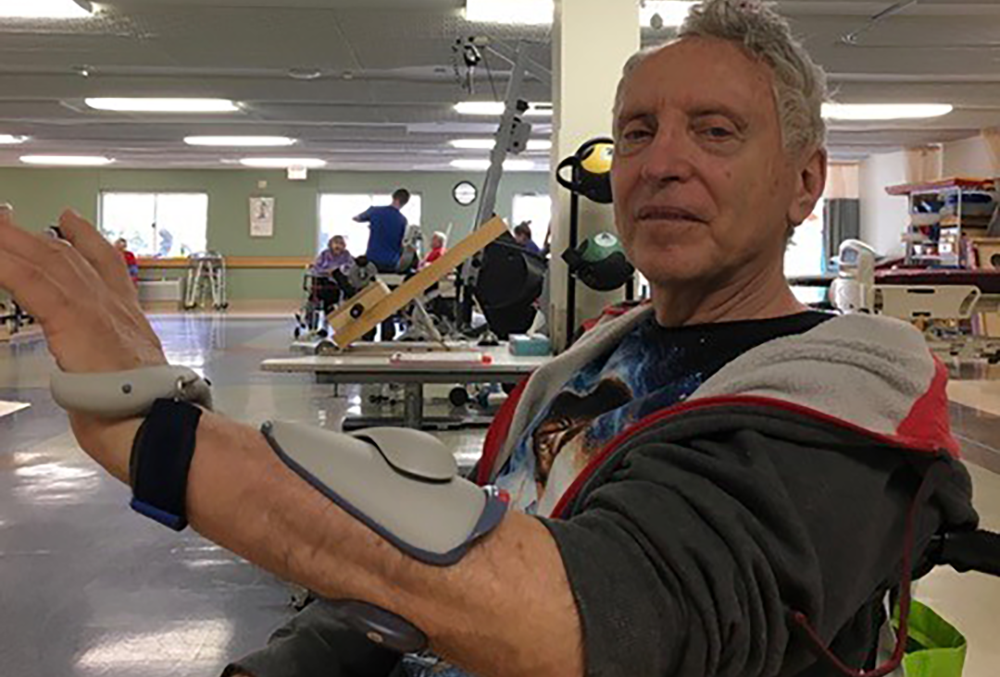
What would you do if you called for help but no one heard you? That’s exactly the predicament in which Jonas Falik found himself one cold February day. A former college professor and the soon-to-retire chair of the business department at Queensborough Community College in Bayside, at 74 Jonas was healthy and active — until he suffered a seizure one morning. Thanks to a team effort from NewYork-Presbyterian Queens, NewYork-Presbyterian Weill Cornell Medicine, Neurosurgeon-in-Chief Philip Stieg, PhD, MD, and the Rehabilitation Medicine team, Jonas is on his way to recovery.
“The day it happened, I’d gone to the gym in the morning and was back in my apartment,” remembers Jonas. “I felt weird and suddenly hit the floor. I knew I had a seizure, I sensed it — and I lay there for five or six hours yelling for help.” Finally in the afternoon a neighbor came home, heard his pleas, and called 911.
An ambulance took him to the closest hospital — NewYork-Presbyterian Queens in Flushing — where Jonas had a CT scan. “They were lovely there,” he recalls. “They asked me to say four words that began with the letter F — imagine the words I said! Their reassurance made me feel like I was going to be okay.”
The CT scan showed a subdural hematoma, which is a pool of blood that forms in the space between the brain and the dura, the outer covering of the brain. “The elderly are more likely to develop these,” says Dr. Stieg. “The human brain loses volume as it ages, so older people have space between the brain and skull that isn’t there in younger people. Bridging that space forces delicate blood vessels to stretch and become vulnerable to minor injuries. A small bump can cause a bleed that goes unnoticed when it happens, but a hematoma is forming. That hematoma puts pressure on the brain, which in Jonas’ case led to a seizure.”
Given the severity of the hematoma, the attending doctor at NewYork-Presbyterian Queens decided that the surgery was best done by Dr. Stieg at the main campus of NewYork-Presbyterian Weill Cornell Medicine. The only thing Jonas remembers about that transfer was the ambulance ride across the Queensboro Bridge. “By the time I got into the city, the medicine they’d given me had kicked in,” he recalls.
“When I saw Jonas, he was suffering from neurological symptoms secondary to the hematoma and the seizure,” recalls Dr. Stieg. “His hematoma was located on the surface of his brain and a mixture of acute and chronic blood, making open surgery the only option. We had to open his skull to get to the affected area of the brain.” Dr. Stieg made a 2-inch incision, opened the skull, and evacuated the hematoma. (The new middle meningeal arterial embolization procedure could not be used initially because of Jonas’ symptoms. It is used as an adjuvant after drainage and resolution of the neurologic symptoms.)
Jonas doesn’t even remember meeting Dr. Stieg before the surgery, and didn’t know at the time he was in the hands of a world-renowned expert. “I didn’t know he was the chair of the department!” he laughs. “But I saw him afterward, when he came into my room to see how I was doing. He has a nice speaking voice and he’s very encouraging. I told him I liked to play golf, and he said, ‘You’ll get back to it. You’ll be playing next year.’”
Recovery was not easy, and Jonas worked with the rehabilitation medicine team for weeks to regain his speech and movement. “I was totally paralyzed on my left side,” he recalls. “It must have taken three or four weeks just to jiggle my fingers and my toes, and then to start walking a little. They encouraged me to walk along the wall with a stick in my hand, to brace and stabilize myself. It was like playing sports again! I remember lying in bed and wiggling my thumb — I was so happy that I moved a little bit.”
Jonas has high praise for the team that worked with him, from the ER in Queens to the OR on the Upper East Side. He is grateful to all who helped get him back on his feet, including the therapists who picked up where neurosurgery left off.
“I remember the rehab team at NYP being very encouraging,” he says. “They pushed me to do therapy — physical therapy, speech therapy — they’d make me walk, they wouldn’t let me quit! They even caught on to me — they knew that when I’d ask for water I wanted to pause the exercise — but nobody let me quit. And I was so impressed because during therapy I would hear English, Greek, Ukrainian — in all these different languages, NYP was helping people. The people there were wonderful. I only have nice things to say about them!”
For others recovering from a similar event, Jonas offers a Winston Churchill quote: “Never give in. Never, never, never, never—in nothing, great or small, large or petty—never give in, except to convictions of honor and good sense.” That, he says, was key to his recovery. “I can understand why people get upset during treatment. But if you can’t lift your legs you have to pick them up and do the best you can. You have to be compliant. Let people who know better help you.”